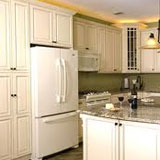LINKS
- Home
- Painting Different Types Of Cabinets
- Professional Painting Cabinets
- Best Way To Paint Cabinets
- Crackle Paint Cabinets
- Distressed Painted Cabinets
- DIY Cabinet Painting
- Faux Paint Cabinets
- How To Glaze Painted Cabinets
- How To Paint Cabinets Antique White
- How To Paint Cabinets
- Paint Cabinets Without Sanding
- Paint Kitchen Cabinets Before And After
- Painted Cabinet Finishes
- Painting Cabinets Black
- Painting Cabinets Bright Colors
- Painting Cabinets White
- Painting File Cabinet
- Painting Varnished Cabinets
- Repainting Cabinets
- Rustoleum Cabinet Paint
- Spray Painting Cabinets
- Staining Painted Cabinets
- Two Tone Painted Kitchen Cabinets
Paint Cabinets Without Sanding
Normally, when you paint your cabinets you need to first strip off the old paint and then you need to sand the surface before applying fresh coats of paint. This helps to make the paint look smooth and the finish will also end up looking more professional. However, it is also possible to paint cabinets without sanding.
Things you will need:
• TSP
• screwdriver
• Paint
• Primer
Here is how you can paint cabinets without sanding:
1. Clean the cabinets with TSP
Start off by cleaning the cabinets with some TSP or trisodium phosphate. This TSP helps in removing every last trace of grease and grime from your cabinets and in addition, it also helps to make the surface dull which then makes it easy for the primer to adhere to the surface of the cabinet. You can shop for TSP at any good hardware store. It is normally kept with other cleaning products.
2. Remove hardware
After cleaning the cabinet with TSP, you then need to remove items of hardware such as the doors and drawers. Once removed, place this hardware and their screws in a zip-lock plastic bag and place the bag in a safe and secure place. The next step involves taping of the walls and counters as well as backsplash. You can use low-tack painters tape for this step. After that, place a drop-cloth on the floor and the counter to ensure that paint does not spoil these surfaces.
3. Apply the primer
Now, you need to use your primer which should be applied on the surface of the cabinet. Be sure to use a primer that is a high quality bonding primer. Since you are painting the cabinets without sanding, you need to ensure that you make use of a primer that is of a good quality. Use the primer to smooth the texture out of your cabinet and it also lays a proper foundation for the application of new coats of paint.
The primer should be applied with the help of a paintbrush and in every corner as well as in places that are not easy to use. After that, be sure to use a smooth foam roller with which to paint the larger parts of the cabinet. You also need to be patient as it may take some time for the primer to dry up completely. Be sure that the primer is absolutely dry before proceeding to the next step.
4. Paint the cabinet
The next step is that of painting the cabinet. It pays to use interior latex or you can also make use of acrylic paint. When applying the paint to the cabinet, you should make use of the same painting techniques as you used when applying the primer. It pays to use a smooth foam roller which will help in applying the paint in a thin and even coat. For more durability, you may want to apply multiple numbers of coats. These additional coats also help in creating a better look. It pays to apply between two and three coats of paint and after each coat has been applied, be sure to allow sufficient time for the coat to dry up completely before applying the next coat.
After painting the cabinet, you must then apply some polyurethane top-coat to the cabinet. When applying the polyurethane, make use of a good quality paintbrush or you can use a clean foam roller. About one or two coats of polyurethane will be enough. Allow forty-eight hours for the polyurethane coat to dry before you think about putting back the cabinets where they were originally installed.

